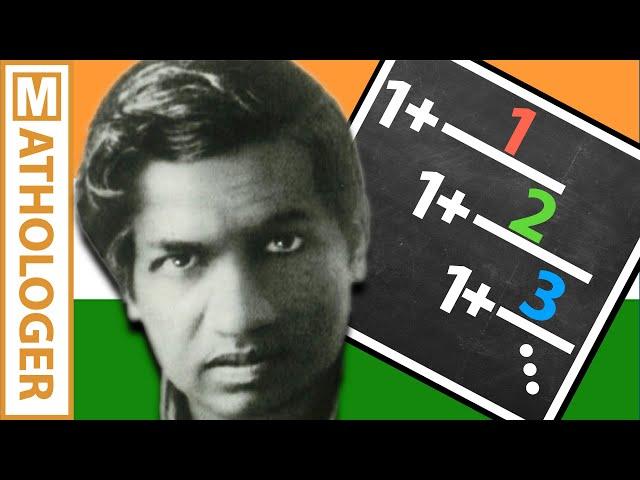
Ramanujan's easiest hard infinity monster (Mathologer Masterclass)
Комментарии:

Drop out the ones from the Wallace product (and its squareroot) and the correspondence would be more clear. Either expression should then appear to converge in the partial products if the alleged final value can be trusted for anything, for much the same reason that -1/12 is a mathematical anomaly rather than a real thing. (Clearly the -1/12 sum diverges.)
Ответить
Here's my take on y' = 1 + xy. RHS looks like product rule folded out, esp. the "xy" bit. So try Ansatz: y = f(x) g(x) -> y' = f g' + f' g and reading off of RHS we get two equations: (1) f g' = 1 and (2) f' g = x f g. Exlude any points g,f=0 -> (2) f'/f = x -> ln(f) = (x^2)/2 + C -> f = C exp((x^2)/2). (Constant C is understood to absorb any manipulation on itself). Plug in f in (1) -> g' = 1/f = C exp(-(x^2)/2) -> g = C erf(x). So y = C exp((x^2)/2) erf(x) and Ansatz worked out nicely. In a sense, the constraint (1) feels like an afterthought, esp. compared to the other ODE presented earlier.
Ответить
I am wondering how many viewers have 1st class math degrees and higher to follow all this. I dont and i cant
Ответить
Another truly amazing video! Ramanujan was amazing, and so are you!
Ответить
So was anyone able to solve Ramanujan's problem, or did he have to present the solution himself?
Ответить
Ramanujan Infinite Sum of the natural numbers: a twelfth of particles, by mass, containing a singularity, is sheared off at an inflection point during a Big Crunch event. If you're going to talk about math, then you should care to explain what it relates to. Stop trying to call the solution to the Basel problem or its reciprocal anything but what it is.
Ответить
Reposting and slight editing of recent mathematical ideas into one post:
Split-complex numbers relate to the diagonality (like how it's expressed on Anakin's lightsaber) of ring/cylindrical singularities and to why the 6 corner/cusp singularities in dark matter must alternate.
The so-called triplex numbers deal with how energy is transferred between particles and bodies and how an increase in energy also increases the apparent mass.
Dual numbers relate to Euler's Identity, where the thin mass is cancelling most of the attractive and repulsive forces. The imaginary number is mass in stable particles of any conformation. In Big Bounce physics, dual numbers relate to how the attractive and repulsive forces work together to turn the matter that we normally think of into dark matter.
The natural logarithm of the imaginary number is pi divided by 2 radians times i. This means that, at whatever point of stable matter other than at a singularity, the attractive or repulsive force being emitted is perpendicular to the "plane" of mass.
In Big Bounce physics, this corresponds to how particles "crystalize" into stacks where a central particle is greatly pressured to break/degenerate by another particle that is in front, another behind, another to the left, another to the right, another on top, and another below. Dark matter is formed quickly afterwards.
i to the i power: the "Big Bang mass", somewhat reminiscent of Swiss cheese, has dark matter flaking off, exerting a spin that mostly cancels out, leaving potential energy, and necessarily in a tangential fashion. This is closely related to what the natural logarithm of the imaginary number represents.
Mediants are important to understanding the Big Crunch side of a Big Bounce event. Matter has locked up, with particles surrounding and pressuring each other. The matter gets broken up into fractions of what it was and then gets added together to form the dark matter known from our Inflationary Epoch. Sectrices are inversely related, as they deal with all stable conformations of matter being broken up, not added like the implosive "shrapnel" of mediants.
Ford circles relate to mediants. Tangential circles, tethered to a line.
Sectrices: the families of curves deal with black holes and dark matter. (The Fibonacci spiral deals with how dark matter is degenerated/broken up and with supernovae. The Golden spiral deals with how the normal matter, that we usually think of, degenerates, forming black holes.) The Archimedean spiral deals with dark matter spinning too fast and breaking into primordial black holes, smaller dark matter, and regular matter. The Dinostratus quadratrix deals with the laminar flow of dark matter being broken up by lingering black holes.
Delanges sectrices (family of curves): dark matter has its "bubbles" force a rapid flaking off - the main driving force of the Big Bang.
Ceva sectrices (family of curves): spun up dark matter breaks into primordial black holes and smaller, galactic-sized dark matter and other, typically thought of matter.
Maclaurin sectrices (family of curves): older, lingering black holes, late to the party, impact and break up dark matter into galaxies.
Dark matter, on the stellar scale, are broken up by supernovae. Our solar system was seeded with the heavier elements from a supernova.
I'm happily surprised to figure out sectrices. Trisectrices are another thing. More complex and I don't know if I have all the curves available to use in analyzing them. But, I can see Fibonacci and Golden spirals relating to the trisectrices.
The Clausen function of order 2: dark matter flakes off, impacting the Big Bang mass directly and shocking the opposite side, somewhat like concussions happen. While a spin on that central mass is exerted, all the spins from all the flaking dark matter largely cancel out. I suspect that primordial black holes are formed by this, as well. Those black holes and older black holes, that came late to the Big Bounce, work together to break up dark matter.
Belows method (similar to Sylvester's Link Fan) relates to dark matter flaking off during a Big Bang event. Repetitious bisection relates to dark matter spinning so violently that it breaks, leaving smaller dark matter, primordial black holes, and other matter. Neusis construction relates to how dark matter is broken up near one of its singularities by an older black hole and to how black holes have their singularites sheared off during a Big Crunch.
General relativity: 8 shapes, as dictated by the equation? 4 general shapes, but with a variation of membranous or a filament? Dark matter mostly flat, with its 6 alternating corner/cusp edge singularities. Neutrons like if a balloon had two ends, for blowing it up. Protons with aligned singularities, and electrons with just a lone cylindrical singularity?
Prime numbers in polar coordinates: note the missing arms and the missing radials. Matter spiraling in, degenerating? Matter radiating out - the laminar flow of dark matter in an Inflationary Epoch? Connection to Big Bounce theory?
"Operation -- Annihilate!", from the first season of the original Star Trek: was that all about dark matter and the cosmic microwave background radiation? Anakin Skywalker connection?

It might be a little too late at this point, and someone else might have already posted something like this in the comments. But I still wanted to give a proof of convergence for the wallis product, and for the divergence of the product of the evens over the product of the odds.
The 1st step is to convert both of those products to infinite series in the following way:
\prod_{i=1}^{\infty} a_i = \prod_{i=1}^{\infty} e^{ln(a_i))} = \lim_{n\to \infty} \prod_{i=1}^{n} e^{ln(a_i)} =\lim_{n \to \infty} e ^ {\sum_{i=1}^{n} ln(a_i)} =e ^ {\lim_{n\to \infty} \sum_{i=1}^{n} ln(a_i))} = e^{\sum_{i=1}^{\infty} ln(a_i)}
(where the second to last transition, where we "put the exponential out of the limit", uses that fact that the exponential function is continuous).
Now we know that to analyze the convergence/divergence of an infinite product, we can analyze the convergence/divergence of the infinite series of the logarithms. This is useful, because now we can use the limit comparison test which states as follows: let a_n, and b_n be two positive sequences, such that the limit \lim_{n\to \infty} a_n / b_n exists, then both infinite series converge, iff the other series converges.
Finally I want to use the known limit: \lim_{x\to 0) ln(1+x)/x = 1 (side note: it might be tempting to try and prove this with l'hopital's rule but this proof is circular) and from that I conclude that for every sequence c_n such that c_n -> 0: \lim_{n \to \infty) ln(1+c_n) / c_n = 1.
Now we are ready for the proofs: for wallis product: a_i = 4(i^2)/(4(i^2)-1), and so ln(a_i) = ln(4(i^2)/(4(i^2)-1)) = ln(1 + 1 / (4(i^2)-1)) we can do a limit comparison test with: b_i = 1 / (4i^2) (whose convergence we can conclude from the integral test) with the sequence c_i = 1 / (4i^2 - 1) as an intermediary, and thus see that the wallis product convergences.
For the other product, we take: a_i = 2i / (2i -1), and so similarly: ln(a_i) = ln(1 + 1 / (2i - 1), we now do we a limit comparison test with b_i = 1 / (2i - 1) which divergences we can conclude due to the the integral test/it being the odd part of the harmonic series/another limit comparison test with the harmonic series.

Wow, that knocked my socks off Professor Polster! Beautiful beyond belief! How can I get back to work now with this spinning in my head! What I need is some tea and some just sitting stupefied, savoring the aftertaste.
Ответить
Fantastic! Amazing. The last bit left unanswered questions, as intended. Everything else was clear.
Ответить
After Euler he his the next Hero for math's
Ответить
Your combination of complex theory, with a simple start, great graphics and robust thought was a true work of art here, very well done. I really appreciated the disclaimer section at the end as the needed warning of not being too glib.
Ответить
Bharat that is India's mathematicians were pure genius but unfortunately they did not get their due respect from this world like Leibniz or Descartes.
Ответить
i'm just here for algorithm engagement =0 Thanks for the video
Ответить
I had never heard of Ramanujan before this video. What an absolute genius. His unfortunate early death set humanity back decades. Imagine how much more he could have done with even just 20 or 30 more years on his planet.
Ответить
Unfortunately, the last formula contains an error. The brackets should be (x/1+x^3/(1*3)+x^5/(1*3*5)+...)
Ответить
What really amazes me about this, is that we found the solution working backwards having already been given the answer. How Ramanujan found this from scratch I will never be able to understand
Ответить
It’s not quite accurate, but the way I like to think of “identities” for diverging sums is that since they diverge, they can’t equal any finite number… but if they could, here’s what they’d be.
Ответить
Ramanujan was like "I know this is true, but you do the proof part" 😅
What a genius

What an amazing identity. A really great video as well, breaking it all down in a very digestible way, thank you!
Ответить
Please could you help me derive y I don’t found it
Ответить
Yet another case in which dividing by one completely changes the answer.
Ответить
If you do the opposite. &/&+1>&÷&/2>2+1>&÷&/3>3+1>&÷&/4 In the end it will be either 1/almost & or 1/almost 0. X < 2 or X > 1.
Ответить
Ramanujan had a particular belief in an invisible helper, teacher, "goddess", which anyone can recognise in themselves as who they talk to when solving problems, ..he was considerably more intense and definite about putting a name on the access to universal memory we share as sense-in-common.
So if you see Euler's symbolic representation of imaginary real-time relative-timing functionality in a specific Singularity-point projection-drawing that you can reconstruct reverse quantization processes to demonstrate how logarithmic condensation self defines.
A Unit Circle derivivation example of the e-Pi-i infinitesimal shaping function projected via Singularity-point Eternity-now 0-1-2-ness Entanglement Fusion-Fission in a picture-plane perspective of resonant unity here-now-forever vanishing-into-no-thing @.dt 1-0-infinity instantaneous trancendental cross-sectional composition of this Holographic Universe.
A reorientation to the Singularity-point Apature, i-reflection orthogonality time-timing or log-antilog nodal-vibrational emitter-receiver relative-timing quantization-bonding reciprocation-recirculation potential crystallisation.., ect, etc, something like another aspect-version of consultation with a personal access to conscious awareness, sense-in-common.., and so on.
Have to come back later to this..

666+666=1332 <=> beast+beast = 1 angel
Ответить
I'm just stoked that I immediately recognized the intro as Ramanujan. Not because I recognized the identity, or am familiar with the math, but simply because any time Mathologer breaks out the continued fractions, it's a one-way ticket to Ramanujan-town.
Ответить
This bothers me. If the wallis product is always true, then the square root of it on both sides should also ALWAYS be true, given we are working with strictly positives. Therefore there is something wrong with the assumption that you can estimate the ramanujan collapsed fraction by looking at the succeeding fractions one at a time (which are always greater than 1 and thus explode to infinity). There are a lot of examples where you can get whatever you want by picking the order of terms of infinite series when finding limits.
Ответить
bah i soooo much love your German influenced way of speaking. Makes it soooö much easier for me to understand English :)
Ответить
what an incredible journey of revelations. I truly appreciate your work in showcase these amazing feats.
Ответить
Amazing
Ответить
Great video, Ramanujan never fails to amaze. Do you plan to at some point cover Ramanujan's constant exp(pi*sqrt(163)) ?
Ответить
Wont ce^(x^2)-1 work
Ответить
Beautiful! With your explanation, I have to wonder if what happened was that Ramanujan was working on the continued fraction, came out with the square-root-and-integral result, and had a "aha" moment of remembering that there was an infinite sum that filled in the other half of the integral and so the sum of the two would be pleasantly simple.
Ответить
Beautiful video!
Ответить
On the positive side: I understand it the way Burkard explains it. Not very easy, but comprehensible. 🙂
On the negative side: I would never be able to come up with this myself 😞

I've spotted a problem. The original one has the sum of all 1/((2n + 1)!!), NOT 1/(n!). Something seems off....
Ответить
Consider: Base 0 vs. Base 1 induction. What about obvious examples presented by Euler? Why is the absence of 0 important, and is there an implication about complex bases. For instance, what about something somewhat arbitrary like Base i induction?
(Hint: Vector notation might struggle with 2,101 A.D.--this is why "war" was beginning at that time.).
Do all your base really belong to us?

Probablemente Ramanujan no estaba seguro de sus pasos. Posiblemente algún tipo de miedo a equivocarse, por ello indicaba que sus fórmulas se las dictaba una diosa mientras dormía. Ramanujan es la encarnación de Euler, pero inseguro de que sus pasos fueran correctos.
Ответить
👍👍👍👍👍
Ответить
You need to live 100 years in genius mode to start understanding what Ramanujan had done.
Ответить
Wonderful 😊
Ответить
Gaussian integral = √π not√2π?
Ответить
How do we solve the second differential equation to end up with e^{\frac{x^2}{2}} \cdot \int_{0}^{x} e^{\frac{-t^2}{2}} dt.
Ответить
This is why I prefer Mozart :)
Ответить
















